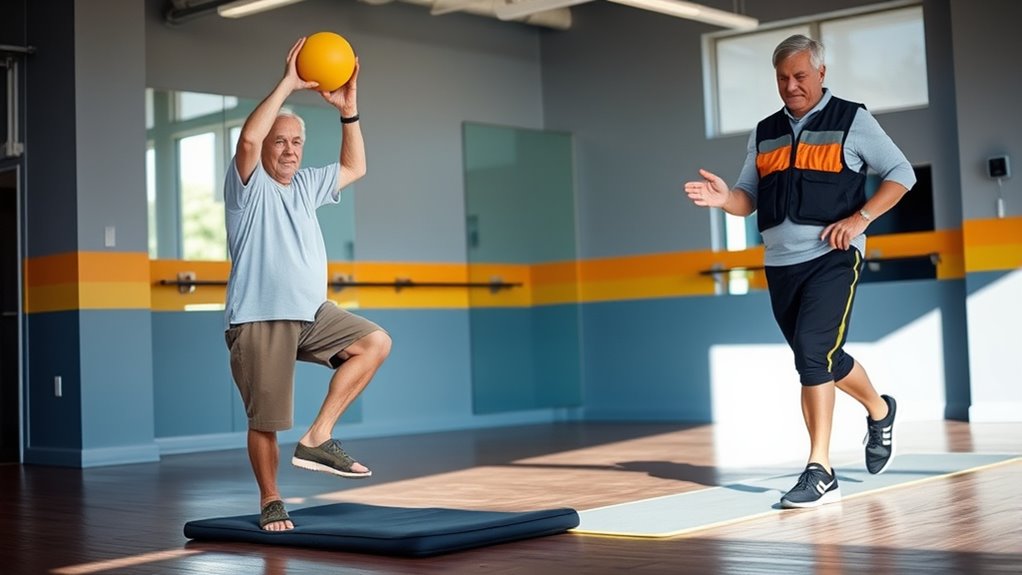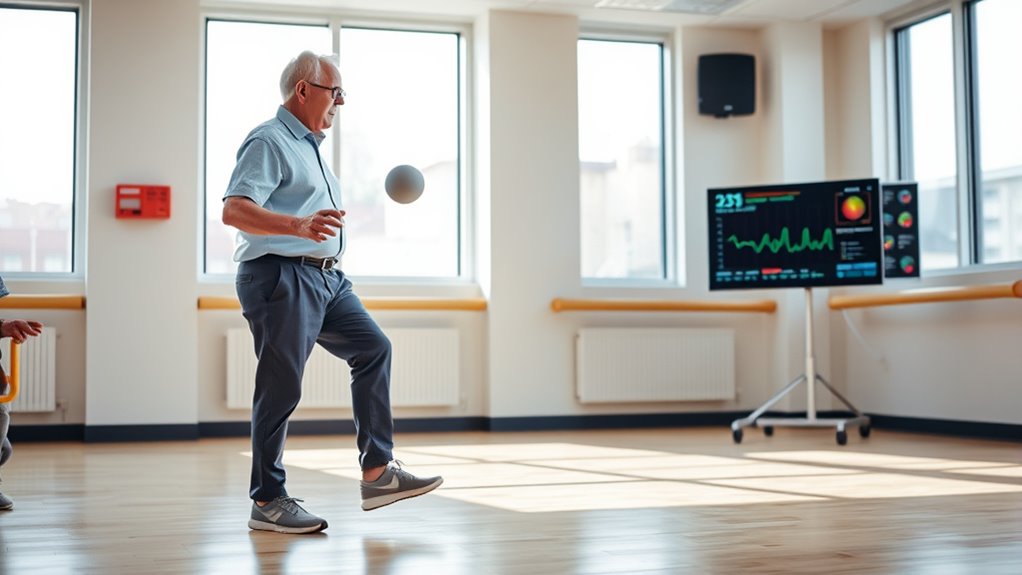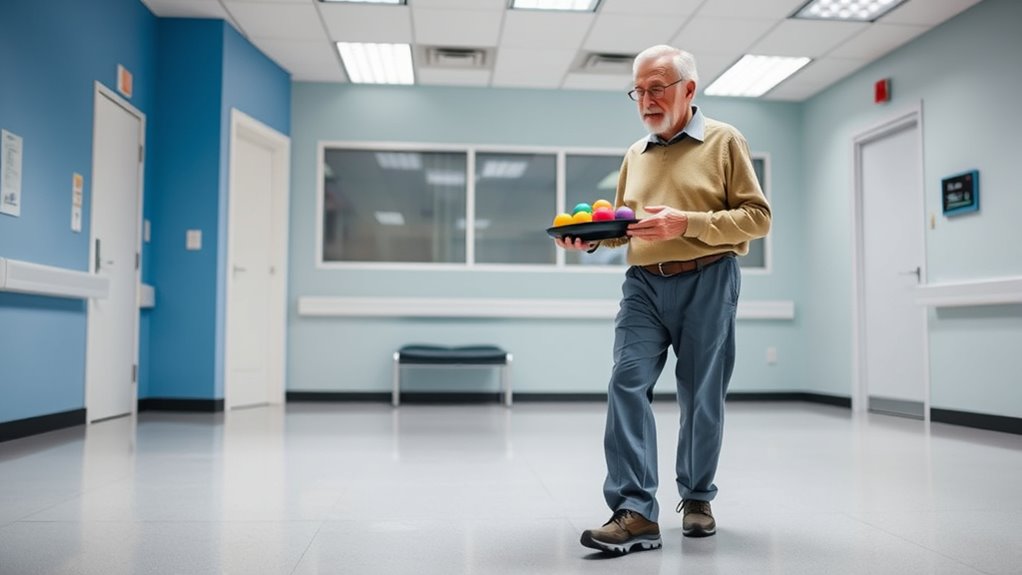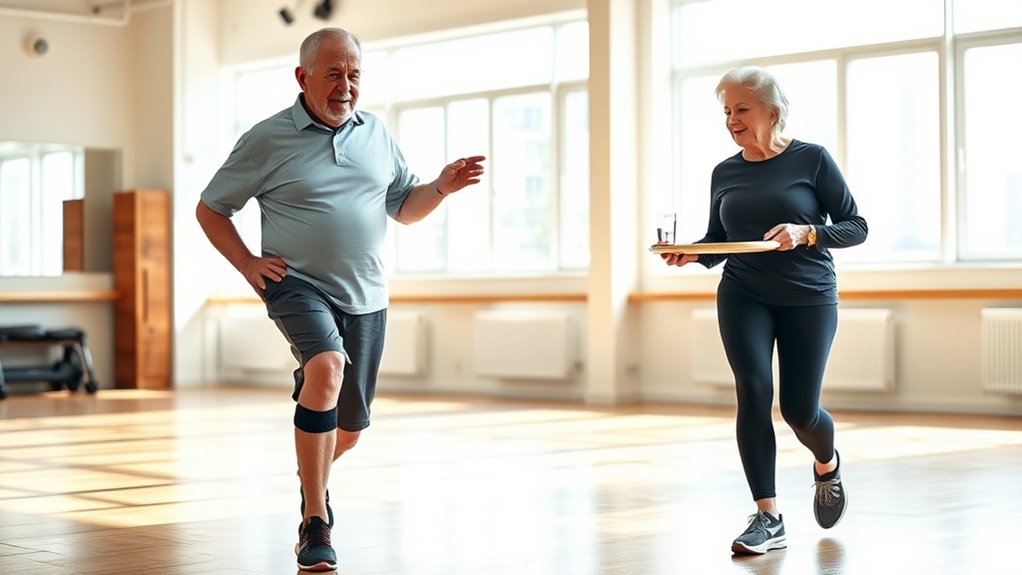Dual-task training involves performing motor and cognitive exercises simultaneously to boost your mobility and reduce fall risk with Parkinson’s. It challenges your brain and body to coordinate more efficiently, improving balance, gait, and multitasking skills over time. By gradually increasing task difficulty and practicing safe routines, you can boost your independence. If you continue exploring, you’ll discover practical strategies and exercises tailored to help you move better and stay safer.
Key Takeaways
- Dual-task training combines motor and cognitive activities to enhance multitasking abilities and improve mobility in Parkinson’s patients.
- It strengthens neural pathways involved in coordination, gait, and balance, promoting neuroplasticity and functional independence.
- Gradually increasing task difficulty ensures continuous progress without overwhelming patients or risking safety.
- Practical exercises include walking while counting or balancing during daily activities, supporting real-world mobility improvements.
- Proper implementation with supervision and tailored activities maximizes benefits and minimizes fall risk during rehabilitation.
Understanding Dual-Task Training and Its Principles

Dual-task training involves performing two activities simultaneously to enhance motor and cognitive abilities, particularly in individuals with Parkinson’s disease. This approach challenges your brain and body to coordinate more efficiently by combining tasks like walking while counting or carrying objects. The core principle is to improve your ability to handle everyday situations where multitasking is common. During training, you focus on maintaining balance, speed, and accuracy while managing two tasks at once. The difficulty can be gradually increased as you improve, ensuring continuous progress. This method aims to strengthen neural pathways responsible for multitasking and coordination. By practicing dual tasks regularly, you can develop better control over your movements and mental focus, ultimately helping you navigate daily life with greater confidence. Incorporating sensory stimulation into training can further enhance your ability to process multiple inputs effectively, and understanding the importance of neural plasticity can motivate consistent practice. Engaging in mindful awareness during exercises can also improve focus and reduce the risk of errors, making the training more effective. Additionally, task-specific training can help in translating these skills to real-world activities. Regular practice of dual-task exercises can also promote brain adaptability, which is vital for improving overall functional mobility.
How Parkinson’s Disease Affects Mobility and Balance

Parkinson’s disease primarily impacts your nervous system, leading to difficulties with movement, balance, and coordination. You may notice a decreased ability to start or stop movements smoothly, often resulting in shuffling steps or stiffness. Balance issues become more apparent, increasing your risk of falls. The disease affects your muscles’ strength and flexibility, making simple tasks more challenging. As the disease progresses, you might experience tremors, rigidity, and slowed movements that interfere with daily activities. Your gait may become uneven, and maintaining posture could become harder. These changes can diminish your independence and confidence. Understanding how Parkinson’s affects your mobility helps you see why targeted interventions, like dual-task training, are essential for improving your stability and overall quality of life. Precise management strategies can further enhance mobility and reduce fall risks.
The Science Behind Dual-Task Interventions

Understanding how dual-task interventions work requires recognizing how they impact your brain and body. These exercises increase cognitive load, engaging neural circuits involved in both thinking and movement. As a result, your motor performance can improve through strengthened neural connections and better coordination. Additionally, leveraging AI-driven diagnostics can help tailor these interventions for maximum effectiveness. Incorporating targeted neuroplasticity techniques can further enhance the brain’s ability to adapt and recover. Recognizing the importance of personalized therapy can optimize treatment outcomes for individuals with Parkinson’s disease. Moreover, integrating holistic health models that address social and mental well-being can support comprehensive recovery, especially when considering the benefits of juice cleansing that promote overall wellness and mental clarity.
Cognitive Load Effects
When the brain manages two tasks simultaneously, it experiences increased cognitive load, which can challenge your ability to perform both activities effectively. This heightened load demands more mental resources, making multitasking more difficult, especially for individuals with Parkinson’s. As cognitive load increases, your attention may become divided, leading to slower responses or errors. This can cause you to prioritize one task over the other, often reducing overall performance. However, with targeted dual-task training, you can gradually adapt to managing higher cognitive loads more efficiently. Over time, your brain learns to allocate resources better, improving your ability to multitask without compromising safety or mobility. Recognizing and managing cognitive load is vital for optimizing dual-task interventions and enhancing functional mobility.
Neural Circuit Engagement
Engaging multiple neural circuits is fundamental to the effectiveness of dual-task interventions. When you perform two tasks simultaneously, your brain activates a network involving the prefrontal cortex, basal ganglia, cerebellum, and motor areas. This widespread engagement promotes neural plasticity, strengthening connections between regions responsible for cognition and movement. In Parkinson’s disease, these circuits often malfunction, impairing mobility and coordination. Dual-task training challenges your brain to coordinate these pathways more efficiently, encouraging adaptive changes. By repeatedly engaging these circuits, you can enhance neural communication, leading to improved task integration and better mobility. This targeted neural engagement is the core of why dual-task interventions hold promise for addressing the underlying neural deficits in Parkinson’s, rather than just compensating for motor impairments.
Motor Performance Enhancement
Dual-task training enhances motor performance by harnessing the brain’s ability to adapt through repeated practice. When you engage in dual tasks, your brain learns to coordinate movement and cognition simultaneously, improving overall efficiency. This process strengthens neural pathways responsible for motor control, leading to smoother, more precise movements. As you practice, your motor system becomes more resilient against the challenges Parkinson’s introduces. Over time, this improves gait, balance, and coordination, even during complex activities. The repeated challenge of dual tasks encourages your brain to optimize resource allocation, reducing the mental effort needed for motor tasks. This not only boosts your physical performance but also enhances confidence and independence in daily activities. Ultimately, consistent dual-task training helps you maintain mobility and quality of life despite disease progression.
Types of Tasks Used in Dual-Task Training Programs

Various types of tasks are combined in dual-task training programs to enhance mobility in individuals with Parkinson’s disease. These tasks typically involve cognitive, motor, or sensory components, challenging your brain and body simultaneously. Common motor tasks include walking, balance exercises, and manual activities like reaching. Cognitive tasks often involve counting, memory, or problem-solving while moving. Sensory tasks may engage visual or tactile inputs to improve perception during movement. Here’s a quick overview:
| Task Type | Example Activities | Focus Area |
|---|---|---|
| Motor | Walking, obstacle courses | Balance, coordination |
| Cognitive | Counting backward, memory tasks | Attention, executive function |
| Sensory | Tactile discrimination, visual tracking | Perception, integration |
| Combined | Dual-task walking with mental math | Multisystem integration |
Engaging in sensory processing tasks can further enhance your ability to interpret and respond to environmental stimuli during movement. Incorporating multisystem training helps improve overall adaptability and neuroplasticity, supporting better functional performance. Additionally, understanding the principles of production quantity variance can assist in optimizing training resources and scheduling to maximize therapeutic outcomes.
Practical Examples of Dual-Task Exercises

Practical dual-task exercises are straightforward to incorporate into daily routines, making them accessible for most individuals with Parkinson’s. For example, you can walk while counting backward or naming items in a category, like animals or fruits. While doing simple chores, try balancing on one foot or stepping over objects, all while engaging in a conversation or listening to music. You might also practice standing up from a chair while recalling a list of words or solving simple math problems aloud. If you’re cooking, try stirring ingredients while reciting a poem or planning your day. These exercises challenge your brain and body simultaneously, helping to improve coordination and cognitive flexibility in everyday situations. Incorporating organic and natural juices into your routine can also support overall health and energy levels, enhancing your ability to perform these exercises consistently. Additionally, understanding regional resources such as local support groups can provide motivation and guidance for maintaining a regular exercise regimen. Utilizing specialized equipment like portable exercise aids can also make dual-task training more effective and manageable for individuals with varying mobility levels. Paying attention to proper pacing can prevent fatigue and ensure safety during activities, maximizing their benefits. Regular practice and gradual difficulty increase will maximize the benefits of these practical activities.
Benefits of Dual-Task Training for Parkinson’s Patients

Engaging in dual-task training offers significant benefits for individuals with Parkinson’s, as it enhances both motor and cognitive functions simultaneously. This approach helps you improve balance, reduce fall risk, and increase overall mobility. It also sharpens your ability to concentrate and switch attention effectively. Incorporating sustainable fashion principles into your routine can further promote long-term health and well-being. Additionally, focusing on essential oils for mobility support may provide complementary benefits by reducing inflammation and promoting relaxation during training sessions. Practicing cognitive-motor integration can optimize the effectiveness of your training and support sustained improvements. Recognizing the importance of father-daughter bond can also inspire motivation and emotional resilience throughout your rehabilitation journey. Developing neuroplasticity through these exercises can enhance your brain’s capacity to adapt and recover more effectively.
Implementing Dual-Task Strategies Safely at Home

To implement dual-task strategies safely at home, start by setting clear safety guidelines to prevent falls or injuries. Begin with simple tasks and gradually increase difficulty as you become more confident, always monitoring your comfort and balance. Adjust your activities as needed to guarantee safety and effectiveness, seeking support if necessary.
Clear Safety Guidelines
Implementing dual-task strategies at home requires careful attention to safety to prevent falls and injuries. First, always ensure the environment is clear of clutter, loose rugs, or obstacles that could cause tripping. Second, wear supportive footwear with good grip to maintain stability. Third, set up a sturdy support, like a chair or countertop, nearby in case you need balance assistance. Fourth, start with simple tasks and gradually increase complexity as your confidence grows. Never attempt dual tasks alone if you feel unsure or unsteady. Regularly check your surroundings for hazards and adjust as needed. Remember, safety comes first—prioritize stability and awareness to reduce the risk of injury while improving mobility.
Start With Simple Tasks
Starting with simple tasks is essential when introducing dual-task strategies at home, especially if you’re new to this approach. Begin with basic activities like walking while counting aloud or balancing on one foot while talking. Keep the tasks manageable to prevent feeling overwhelmed or risking injury. Focus on maintaining safety and proper technique, and don’t push yourself too hard initially. As you become more comfortable, gradually increase the complexity or duration of the tasks. Remember, the goal is to challenge your brain without compromising your safety. Starting simple helps build confidence and ensures you can perform the activities correctly. This way, you set a solid foundation for more advanced dual-task exercises later on.
Monitor and Adjust
How can you guarantee dual-task exercises remain safe and effective at home? First, observe your responses carefully—notice signs of fatigue, dizziness, or loss of balance. Second, adjust the difficulty level based on your current ability; if a task feels overwhelming, simplify it. Third, maintain a safe environment by clearing clutter and using sturdy support if needed. Fourth, keep a training journal to track your progress and setbacks, helping you identify patterns and necessary changes. Regularly reassess your performance, and don’t hesitate to modify your routine or seek guidance from a healthcare professional. Monitoring your reactions and adapting accordingly ensures that your dual-task training remains both safe and beneficial, helping you build confidence and improve mobility without risking injury.
Integrating Dual-Task Training Into Rehabilitation Programs

To effectively incorporate dual-task training into rehabilitation programs, you must carefully design interventions that seamlessly blend cognitive and motor exercises. Start by selecting activities that challenge both aspects without causing frustration or fatigue. For example, combine walking with simple mental tasks like naming objects or counting backward. Tailor the difficulty to each patient’s ability, gradually increasing complexity as they improve. Incorporate these exercises into regular therapy sessions to encourage consistency. Use real-world scenarios so patients can transfer skills to daily life. Remember to monitor performance closely, providing feedback and adjustments as needed. The goal is to enhance multitasking ability without overwhelming the patient. By thoughtfully integrating dual-task exercises, you can maximize their potential to improve mobility and functional independence.
Challenges and Considerations in Dual-Task Practice

Implementing dual-task practice presents several challenges, primarily because balancing cognitive and motor demands can overwhelm patients or compromise safety. You need to carefully select tasks that match the patient’s ability level to prevent frustration or injury. Monitoring progress is essential, but it can be difficult to find the right balance between challenge and safety. Consider these key factors:
Balancing cognitive and motor tasks requires careful selection and supervision to ensure safety and progress.
- Ensure tasks are appropriately challenging without causing frustration or fatigue.
- Gradually increase complexity to prevent cognitive overload.
- Maintain constant supervision to minimize fall risk.
- Adjust tasks based on individual response, avoiding a one-size-fits-all approach.
Future Directions and Research in Dual-Task Approaches

Advances in technology and a deeper understanding of Parkinson’s disease are shaping the future of dual-task training. You can expect more personalized interventions using wearable sensors and real-time feedback, making training more adaptable to individual needs. Research will likely focus on optimizing task complexity and timing to maximize benefits while minimizing fatigue. Virtual reality and gaming platforms might become standard tools, providing engaging environments that challenge both cognitive and motor skills simultaneously. Additionally, future studies will explore integrating dual-task training into daily routines, promoting long-term adherence. You should also see increased collaboration between clinicians and researchers to develop standardized protocols and identify biomarkers that predict responsiveness. These innovations aim to improve mobility, reduce falls, and enhance quality of life for people with Parkinson’s.
Frequently Asked Questions
How Long Does It Take to See Improvements With Dual-Task Training?
You might wonder how quickly you’ll notice changes from dual-task training. Typically, you can start seeing improvements within a few weeks, often around 4 to 6 weeks of consistent practice. Your progress depends on how often you train and your individual condition. Stick with the exercises, stay motivated, and you’ll likely experience better mobility, balance, and confidence over time. Regular sessions are key to achieving lasting benefits.
Can Dual-Task Training Be Personalized for Different Parkinson’S Stages?
You wonder if dual-task training can be tailored to different Parkinson’s stages. Absolutely! You can customize exercises to match your specific needs, focusing on your current abilities and challenges. Early stages might involve simple tasks, while advanced stages could require more supportive, simplified routines. Personalization helps you progress safely and steadily, making your movement more manageable and meaningful, no matter where you are in your Parkinson’s journey.
Are There Any Risks or Side Effects Associated With Dual-Task Exercises?
You might wonder if dual-task exercises have risks. While they can improve mobility, you should be aware of potential issues like fatigue, loss of balance, or frustration if tasks become too difficult. Always start slowly and increase difficulty gradually. It’s best to do these exercises under supervision or with guidance from a healthcare professional to minimize risks and guarantee safety as you work on improving your mobility.
How Often Should Dual-Task Training Sessions Be Performed Weekly?
Imagine your progress as a delicate seed needing consistent rain. You should aim for dual-task training two to three times weekly, giving your body time to adapt and grow stronger. Regular sessions act as nourishing drops, helping you regain confidence and mobility. Be mindful not to overdo it; balance is key. With steady effort, you’ll nurture resilience and see meaningful improvements in your daily life.
Is Dual-Task Training Effective for Other Neurological Conditions?
You might wonder if dual-task training helps with other neurological conditions. It often proves effective because it challenges your brain and motor skills simultaneously, improving overall function. Conditions like stroke, multiple sclerosis, and traumatic brain injury can benefit from this approach. By practicing dual tasks, you enhance cognitive flexibility, coordination, and balance, making daily activities easier. So, yes, dual-task training shows promise across various neurological disorders beyond Parkinson’s.
Conclusion
By incorporating dual-task training into your routine, you’ll tackle mobility and balance challenges head-on. It’s not just about doing two things at once but about strengthening your mind and body together. Remember, practice makes perfect, and with patience, you’ll see progress. Don’t let the grass grow under your feet—embrace these strategies now, and you’ll be taking steps in the right direction. Keep pushing forward; your mobility journey is worth the effort!









